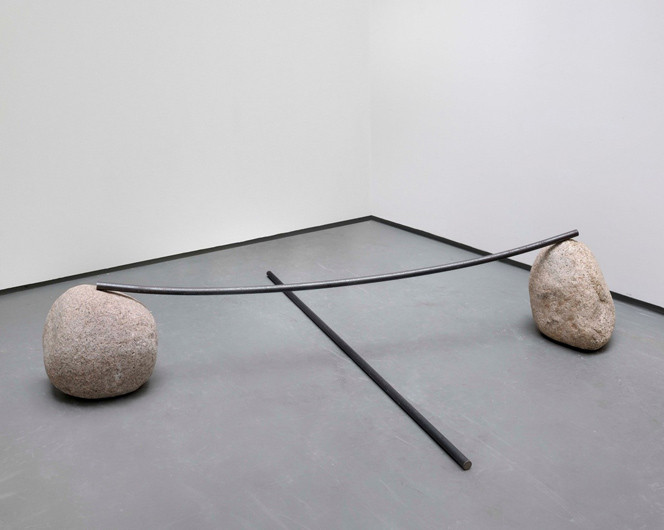Lee Ufan
14 Apr - 18 Jun 2011

© Lee Ufan
Relatum - counterpoint, 2004
Iron plate, natural stone
250 cm (total length with the stones)
200 x 3 cm (79 x 1 in) = 2 (metal bars)
30 x 30 cm (12 x 12 in) = 2 (stones)
Relatum - counterpoint, 2004
Iron plate, natural stone
250 cm (total length with the stones)
200 x 3 cm (79 x 1 in) = 2 (metal bars)
30 x 30 cm (12 x 12 in) = 2 (stones)
LEE UFAN
Paintings and Sculptures
14 April – 18 June, 2011
We are delighted to announce Lee Ufan's first solo exhibition in Salzburg. With his Zen-inspired paintings and sculptures, the Korean artist creates a meditative awareness of the boundaries of the interior life - the self - in relation to the exterior life, the world. His works represent a metaphor for calm, strict simplicity and a philosophical, minimalist view. A few brush-strokes on large white canvases set the basics for the process of painting; with no need for accessories, sculptures bring out the essence of the materials steel and stone - a vibrant, aesthetic invitation to the viewer to become receptive to their intensive spirituality and subtle energy.
Lee Ufan was born in Kyongnam, Korea, in 1936. After studying at Seoul National University, he settled in Japan in 1956, and in 1961 he completed his studies in the Department of Philosophy at Nihon University in Tokyo. During the years following 1969, he was counted amongst the pioneers of the experimental group Mono-ha (school of things). In the early 1970s, he was appointed professor at Tama Art University in Tokyo, where he taught until 2007. Today he lives in Paris and Japan. In 1997 he was invited to Paris as guest professor at the École Nationale Supérieure des Beaux-Arts. That same year, Daniel Abadie curated Lee Ufan's major exhibition in the Jeu de Paume. In 2001 he was awarded the prestigious Praemium Imperiale for painting. In 2005, the Musée d'Art Moderne in Saint Etienne, France, held a comprehensive exhibition of his work. In recent years, exhibitions have been held in the Musées royaux des Beaux-Arts in Brussels (2008) and the Infinitum exhibition in the Palazzo Fortuny, presented concurrently with the 57th Venice Biennale.
The exhibition is accompanied by a catalogue containing Lee Ufan's own writings on art, an interview with Lorand Hegyi and an article by Daniel Abadie.
Paintings and Sculptures
14 April – 18 June, 2011
We are delighted to announce Lee Ufan's first solo exhibition in Salzburg. With his Zen-inspired paintings and sculptures, the Korean artist creates a meditative awareness of the boundaries of the interior life - the self - in relation to the exterior life, the world. His works represent a metaphor for calm, strict simplicity and a philosophical, minimalist view. A few brush-strokes on large white canvases set the basics for the process of painting; with no need for accessories, sculptures bring out the essence of the materials steel and stone - a vibrant, aesthetic invitation to the viewer to become receptive to their intensive spirituality and subtle energy.
Lee Ufan was born in Kyongnam, Korea, in 1936. After studying at Seoul National University, he settled in Japan in 1956, and in 1961 he completed his studies in the Department of Philosophy at Nihon University in Tokyo. During the years following 1969, he was counted amongst the pioneers of the experimental group Mono-ha (school of things). In the early 1970s, he was appointed professor at Tama Art University in Tokyo, where he taught until 2007. Today he lives in Paris and Japan. In 1997 he was invited to Paris as guest professor at the École Nationale Supérieure des Beaux-Arts. That same year, Daniel Abadie curated Lee Ufan's major exhibition in the Jeu de Paume. In 2001 he was awarded the prestigious Praemium Imperiale for painting. In 2005, the Musée d'Art Moderne in Saint Etienne, France, held a comprehensive exhibition of his work. In recent years, exhibitions have been held in the Musées royaux des Beaux-Arts in Brussels (2008) and the Infinitum exhibition in the Palazzo Fortuny, presented concurrently with the 57th Venice Biennale.
The exhibition is accompanied by a catalogue containing Lee Ufan's own writings on art, an interview with Lorand Hegyi and an article by Daniel Abadie.
